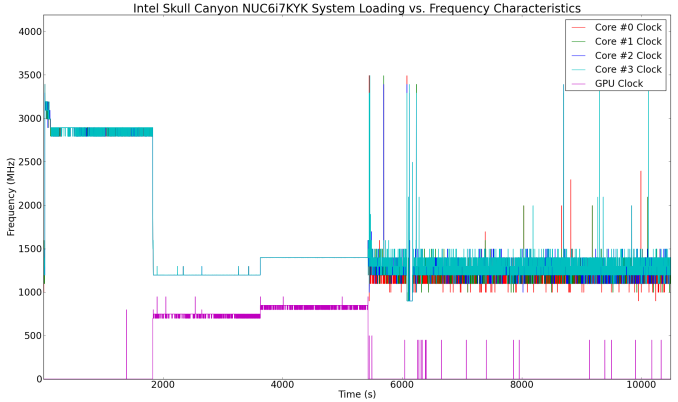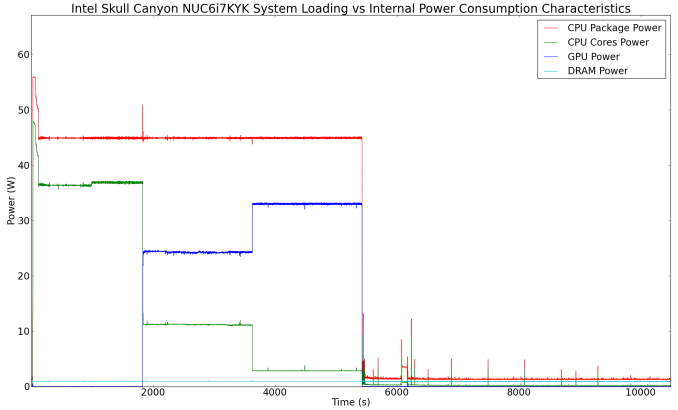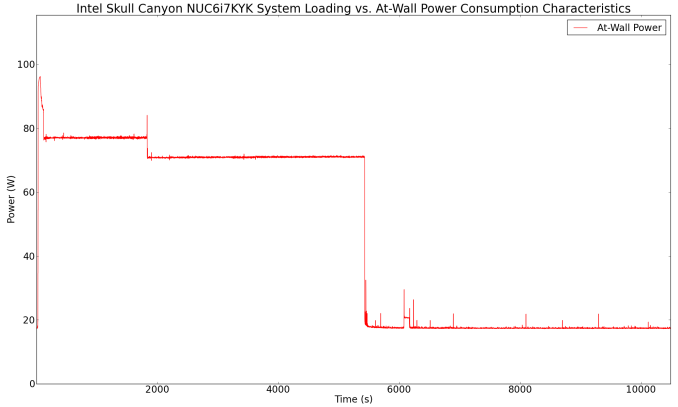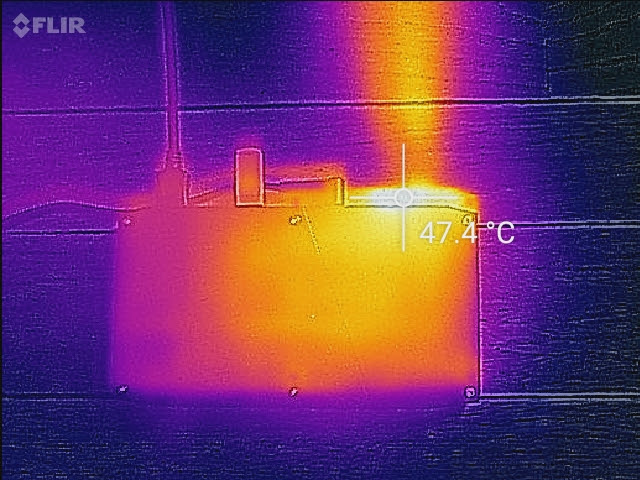The Intel Skull Canyon NUC6i7KYK mini-PC Review
by Ganesh T S on May 23, 2016 8:00 AM ESTPower Consumption and Thermal Performance
The power consumption at the wall was measured with a 1080p display being driven through the HDMI port. In the graphs below, we compare the idle and load power of the Intel NUC6i7KYK (Skull Canyon) with other low power PCs evaluated before. For load power consumption, we ran Furmark 1.12.0 and Prime95 v27.9 together. The idle number is a bit disappointing, though, I assume that a change in the BIOS to the low power profile could help improve things. Otherwise, the idle number is just slightly higher than what is typical for a system with a 45W TDP CPU and a PCIe M.2 SSD.


The load power number in the graph above is the maximum sustained value. As we can see from the graphs below, instantaneous peak numbers can go as high as 95W. Addition of bus-powered USB devices will also tend to drive up this number further.
Our thermal stress routine starts with the system at idle, followed by 30 minutes of pure CPU loading. This is followed by another 30 minutes of both CPU and GPU being loaded simultaneously. After this, the CPU load gets removed, allowing the GPU to be loaded alone for another 30 minutes. The various clocks in the system as well as the temperatures within the unit are presented below.
The graph below present the power consumption profile of various blocks in the CPU package during the course of our thermal stress. Following that, we have the power consumption at the wall for the system during the same period.
According to the official specifications, the junction temperature of the Core i7-6770HQ is 100 C. Unfortunately, the cooling solution is not able to prevent the CPU from hitting it with turbo speeds activated. However, the frequency does remain above the base 2.6 GHz throughout the pure CPU loading segment. The package power settles down to a steady 45W, and that continues throughout the duration of our test. Our only concern is that the cooling solution keeps the temperature of the cores too close to the junction temperature during periods of heavy CPU load. Once the load gets distributed across both the CPU and the GPU, we see the package come down to around 90C.
Another important aspect to keep note of while evaluating mini-PCs is the chassis temperature. Using the Android version of the FLIR One thermal imager, we observed the chassis temperature after the CPU package temperature reached the steady state value in the above graph.
We have additional thermal images in the gallery below.
The maximum chassis temperature observed by the thermal imager was slightly above 60 C near the fan's exhaust vent. At that point, a sound level Android app running on the HTC One M7 recorded 59 dB. For comparison purposes, the Zotac ZBOX MAGNUS EN970 recorded 50 dB in a similar scenario.







_thumb.jpg)

_thumb.jpg)

_thumb.jpg)









133 Comments
View All Comments
jann5s - Wednesday, May 25, 2016 - link
very fun read indeed, thx for the linkkgardas - Wednesday, May 25, 2016 - link
Demo a system on lot of virtualized machines. ECC is a must have for server workloads and although a chance that the demo will fail due to flip-bit is low, still man would rather not risk that at customer premises right?hubick - Monday, May 23, 2016 - link
It would be really cool to see them make a Xeon-D based NUC oriented for home NAS/router/micro-server use, with dual M.2 for onboard RAID 0/1, Thunderbolt for external storage, a minimal GPU, ECC RAM, and dual 10GBase-T support!TeXWiller - Monday, May 23, 2016 - link
That could cost an ARM, though. ;)BurntMyBacon - Tuesday, May 24, 2016 - link
I'd give up an "ARM" for that. ;')lper - Monday, May 23, 2016 - link
100% agree. If you known how high tech DRAM is and how easy it goes wrong (just google for rowhammer...). I spend already a hughe amount of time to figure out RAM issues which have ECC (as otherwise you would not notice) in embedded systems, that I do not trust RAM without ECC anymore.Still waiting on the first xeon laptop without quadro (which just drains power and produces heat...) but with ECC. I use my computer for work, not for playing games. So if it can drive the display size used, then it is ok... I do not want any laptop with an extra GPU, but I want the ECC.
Ratman6161 - Tuesday, May 24, 2016 - link
"I use my computer for work, not for playing games."Which is to say that this hardware is not being marketed at you in the first place.
JKflipflop98 - Wednesday, May 25, 2016 - link
Exactly what part of this device tells you "this is for doing serious business"? Was it the big skull on the front panel?jihe - Wednesday, May 25, 2016 - link
This can be better with free beer support. I just can not use any machine without beer for work.Ethos Evoss - Thursday, May 26, 2016 - link
I can PISS on this for that taking piss price !!!